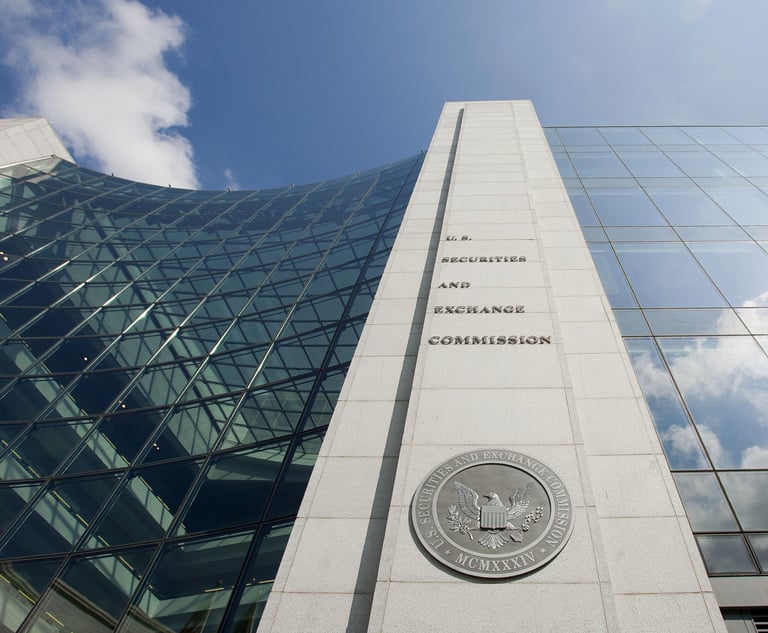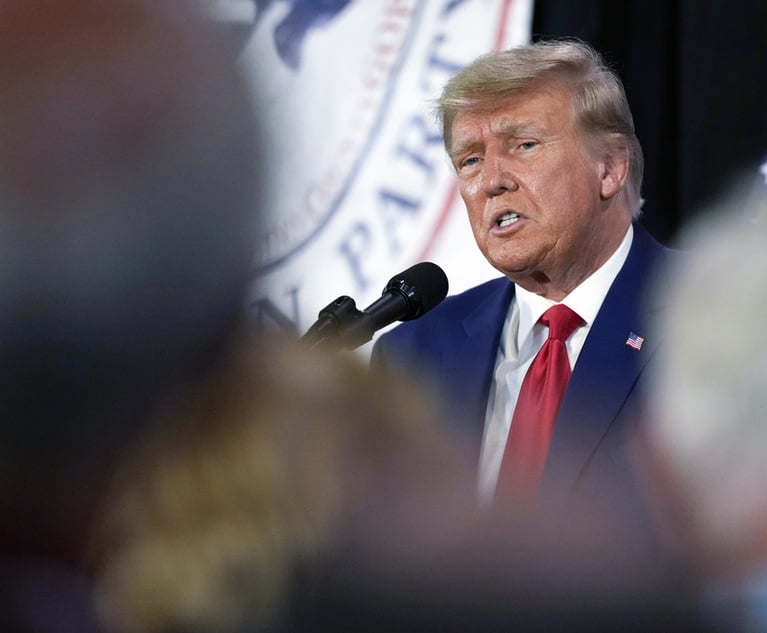The Latest Trends in IP Crime
Today, counterfeit products make up about eight percent of world trade, totaling a whopping $1.7 trillion, with much of the revenues from large-scale operations…
September 01, 2017 at 06:53 PM
4 minute read
The original version of this story was published on Law.com
Today, counterfeit products make up about eight percent of world trade, totaling a whopping $1.7 trillion, with much of the revenues from large-scale operations going to organized crime.
“As consumers shop more online, we have seen a corresponding increase in counterfeit products bought online,” explained Paul Brown, UL's (Underwriters Laboratories) Vice President of Intellectual Property & Litigation. “Products are no longer simply shipped on pallets to distributor, but are often shipped directly to consumers from sellers using online marketplaces. It is very challenging for online marketplaces with millions of sellers to completely know their supply chains and for consumers to know they are getting genuine products.”
Brown sat down with Inside Counsel for an exclusive interview on the latest trends in intellectual property crime and key players that are heavily affected, best practices for combating IP crime, and new tools and initiatives that are being implemented by law enforcement officials, and key considerations to help organizations and brands protect their IP and promote anti-counterfeiting
IP crime threatens the health and safety of consumers, causes billions of dollars of economic loss to legitimate businesses, and can ultimately stifle innovation. Because working for a safer word is a key part of UL's mission, Brown and his team are concerned about the threat that counterfeits pose to consumer safety because oftentimes counterfeit products are shoddy, low quality and in some cases extremely dangerous.
“The effects of counterfeiting are not limited to consumers — retailers and manufacturers also feel the aftermath,” he said. “Counterfeiting steals from legitimate businesses and often supports organized crime. By protecting our mark, we are helping our clients ensure the legitimacy of their products and services and are also stopping counterfeits from entering the marketplace.”
UL recently partnered with INTERPOL to develop the International IP Crime Investigators College (IIPCIC) with a mission to deliver world-class IP education to law enforcement agencies and other stakeholders around the world. This initiative helps law enforcement officials effectively communicate and cooperate in the fight against counterfeiting and IP crimes. The college is delivered on a multilingual platform and offers IP related courses in English, Spanish, French, Arabic, Mandarin and Portuguese to over 12,500 learners that represent 454 global organizations from 144 countries.
“We launched a new curriculum this year, specifically for global customs officers, that will provide information and case studies on their role securing supply chains and encouraging transnational cooperation between agencies,” Brown said. “IIPCIC also provides a platform for rights holders to deliver customized e-Learning courses to the approximately 11,000 law enforcement and customs officials who are registered on the IIPCIC platform.”
Each year, the U.S. Department of Justice awards money to various agencies that apply for an intellectual property theft grant. The money allows the receiving agencies to focus on combating counterfeiting. UL makes it a priority each year to engage the relevant agencies and educate them on current trends and anti-counterfeiting measures as they relate to UL.
What are best practices for combating IP crime?
According to Brown, dedicate an internal team to identifying, investigating and taking appropriate action against IP infringements. “This may not be possible for some companies with budget constraints but they can collaborate with outside counsel, investigators, law enforcement and others to build up their brand protection capabilities,” he said.
Additionally, it is essential to educate and train law enforcement on your brand if you want them to be able to spot fakes. At UL, they train customs and other government agencies around the world on how to differentiate real vs. counterfeit UL marks. Their investigation team is led by former law enforcement officers, all of whom have specialized experience in investigating and prosecuting counterfeiting offenses.
“Brand owners also need to consider all the options available in a particular case, such as working with customs to prevent counterfeit products from entering the stream of commerce, assisting law enforcement in pursuing a criminal case, and/or filing an independent civil action against a counterfeiter,” he explained.
And finally, according to Brown, brand owners should take advantage of the many resources available for networking and sharing best practices with other brand owners, government agencies and third-party services provides for fighting counterfeiting and other IP crime, such as the International IP Crime Conference, the International Trademark Association and the International Anti-Counterfeiting Coalition.
This content has been archived. It is available through our partners, LexisNexis® and Bloomberg Law.
To view this content, please continue to their sites.
Not a Lexis Subscriber?
Subscribe Now
Not a Bloomberg Law Subscriber?
Subscribe Now
NOT FOR REPRINT
© 2024 ALM Global, LLC, All Rights Reserved. Request academic re-use from www.copyright.com. All other uses, submit a request to [email protected]. For more information visit Asset & Logo Licensing.
You Might Like
View All
SEC Penalizes Wells Fargo, LPL Financial $900,000 Each for Inaccurate Trading Data

US Reviewer of Foreign Transactions Sees More Political, Policy Influence, Say Observers

Pre-Internet High Court Ruling Hobbling Efforts to Keep Tech Giants from Using Below-Cost Pricing to Bury Rivals
6 minute read
Preparing for 2025: Anticipated Policy Changes Affecting U.S. Businesses Under the Trump Administration
Trending Stories
- 1Revisiting the Boundaries Between Proper and Improper Argument: 10 Years Later
- 2Hochul Vetoes 'Grieving Families' Bill, Faulting a Lack of Changes to Suit Her Concerns
- 3Life, Liberty, and the Pursuit of Customers: Developments on ‘Conquesting’ from the Ninth Circuit
- 4Biden commutes sentences for 37 of 40 federal death row inmates, including two convicted of California murders
- 5Avoiding Franchisor Failures: Be Cautious and Do Your Research
Who Got The Work
Michael G. Bongiorno, Andrew Scott Dulberg and Elizabeth E. Driscoll from Wilmer Cutler Pickering Hale and Dorr have stepped in to represent Symbotic Inc., an A.I.-enabled technology platform that focuses on increasing supply chain efficiency, and other defendants in a pending shareholder derivative lawsuit. The case, filed Oct. 2 in Massachusetts District Court by the Brown Law Firm on behalf of Stephen Austen, accuses certain officers and directors of misleading investors in regard to Symbotic's potential for margin growth by failing to disclose that the company was not equipped to timely deploy its systems or manage expenses through project delays. The case, assigned to U.S. District Judge Nathaniel M. Gorton, is 1:24-cv-12522, Austen v. Cohen et al.
Who Got The Work
Edmund Polubinski and Marie Killmond of Davis Polk & Wardwell have entered appearances for data platform software development company MongoDB and other defendants in a pending shareholder derivative lawsuit. The action, filed Oct. 7 in New York Southern District Court by the Brown Law Firm, accuses the company's directors and/or officers of falsely expressing confidence in the company’s restructuring of its sales incentive plan and downplaying the severity of decreases in its upfront commitments. The case is 1:24-cv-07594, Roy v. Ittycheria et al.
Who Got The Work
Amy O. Bruchs and Kurt F. Ellison of Michael Best & Friedrich have entered appearances for Epic Systems Corp. in a pending employment discrimination lawsuit. The suit was filed Sept. 7 in Wisconsin Western District Court by Levine Eisberner LLC and Siri & Glimstad on behalf of a project manager who claims that he was wrongfully terminated after applying for a religious exemption to the defendant's COVID-19 vaccine mandate. The case, assigned to U.S. Magistrate Judge Anita Marie Boor, is 3:24-cv-00630, Secker, Nathan v. Epic Systems Corporation.
Who Got The Work
David X. Sullivan, Thomas J. Finn and Gregory A. Hall from McCarter & English have entered appearances for Sunrun Installation Services in a pending civil rights lawsuit. The complaint was filed Sept. 4 in Connecticut District Court by attorney Robert M. Berke on behalf of former employee George Edward Steins, who was arrested and charged with employing an unregistered home improvement salesperson. The complaint alleges that had Sunrun informed the Connecticut Department of Consumer Protection that the plaintiff's employment had ended in 2017 and that he no longer held Sunrun's home improvement contractor license, he would not have been hit with charges, which were dismissed in May 2024. The case, assigned to U.S. District Judge Jeffrey A. Meyer, is 3:24-cv-01423, Steins v. Sunrun, Inc. et al.
Who Got The Work
Greenberg Traurig shareholder Joshua L. Raskin has entered an appearance for boohoo.com UK Ltd. in a pending patent infringement lawsuit. The suit, filed Sept. 3 in Texas Eastern District Court by Rozier Hardt McDonough on behalf of Alto Dynamics, asserts five patents related to an online shopping platform. The case, assigned to U.S. District Judge Rodney Gilstrap, is 2:24-cv-00719, Alto Dynamics, LLC v. boohoo.com UK Limited.
Featured Firms
Law Offices of Gary Martin Hays & Associates, P.C.
(470) 294-1674
Law Offices of Mark E. Salomone
(857) 444-6468
Smith & Hassler
(713) 739-1250






